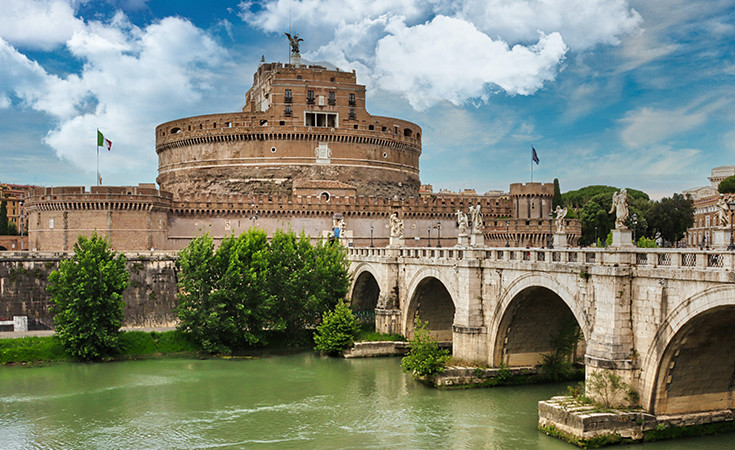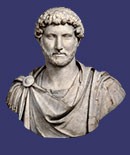
Apart from Colosseum and Vatican Museum, Castel Sant’ Angelo is one of the most important tourist attraction of Rome. It is one of the buildings that survived from the ancient times, and whoever decides to visit it will be amazed by the view from the last level of the structure, from where Rome glows in its raw beauty.
 This impressive structure was erected between 123 and 139 AD by Roman Imperator Publio Elio Traiano Adriano, better known as Imperator Hadrian (also a constructor of Hadrian’s Wall in today’s Great Britain). This building served as his final resting place where both his and his wife’s and family’s ashes were placed. It was constructed on the western bank of the river Tiber (Tevere) and was connected to the city by the Elio bridge that is still standing but in its more modern baroque look decorated with sculptures of angels (by sculptor Gian Lorenzo Bernini). For a century, the building was only a thumb, but then Imperator Aurelian included it into the defensive system of the city because of its height and beneficial strategic position.
This impressive structure was erected between 123 and 139 AD by Roman Imperator Publio Elio Traiano Adriano, better known as Imperator Hadrian (also a constructor of Hadrian’s Wall in today’s Great Britain). This building served as his final resting place where both his and his wife’s and family’s ashes were placed. It was constructed on the western bank of the river Tiber (Tevere) and was connected to the city by the Elio bridge that is still standing but in its more modern baroque look decorated with sculptures of angels (by sculptor Gian Lorenzo Bernini). For a century, the building was only a thumb, but then Imperator Aurelian included it into the defensive system of the city because of its height and beneficial strategic position.
According to the legend, in 509 during a plague outbreak, Pope Gregory I had a vision that he should lead a procession towards the Mausoleum. When the procession reached the Mausoleum, Pope had a vision of Archangel Michael on top of the building sheathing his sword. Gregory interpreted this vision as a sign that the epidemic would stop. From that day, the building got its new name - Castle Sant Angelo. This is why there is a gilded statue of Archangel Michael sheathing his sword on top of the building.
After this event, the castle slowly passed to the Papacy. In the 13th century, Pope Nicolo III (Nicholas III) built the protected passage called “Pasetto di Borgo” between the Basilica Sent Pitter and the castle, because he considered the Vatican Palace to be insufficiently secure.
In the 15th century, the Papal residence was built within the castle and was lavishly decorated. Over the years, the castle was additionally fortified which allowed Pope Clemente VII to resist the siege of Carlo V for 7 months.
For years, the castle was used for political prisoners where many famous individuals met their end just like Giordano Bruno, a famous poet, mathematician, philosopher and astrologer.
After the Unity of Italy, at first the castle was used as army barracks and slowly it became a museum.
There is a collection of arms, sculptures and paintings, though it is not as rich as other museums in Rome. The castle offers a great view on many levels of the building, and the view from the top of the building is spectacular - you can see most of Rome from up there.
(!) Mind the steps! But really, mind the steps. We witnessed a man falling down and hurting himself. Due to negligence, the steps are worn out, and you need to balance your weight while going down.
Ticket price for Castel Sant’ Angelo in Rome
Regular ticket price is 10 Euros (€), (varies in case of an additional exhibition in the castle)
Reduced ticket price is 5 Euros (€).
Free entrance: citizens of EU younger than 18, disabled individuals with their companions.
Reduced price: citizens of EU between 18 and 25 years.
We advise you to check the ticket price before visiting on the official website of the Castel Sant’Angelo.
Working Hours of Castel Sant’Angelo in Rome
From Tuesday to Sunday working hours are: 9:00– 19:30h.
Closed: Mondays, January 1st, December 25th.
We advise you to check the working hours before visiting on the official website of the Castel Sant’Angelo.
Interesting facts